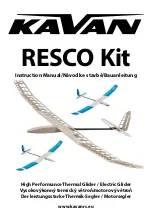
Page
10
of
27
STARTING
When the engine is cold, prime three to five strokes after turning fuel valve to the on position. Push mixture
control to full rich, carburetor heat off, and open throttle about one-eighth of an inch or until the intake of air at
the carburetor can be heard when the engine is pulled through by hand. Engine should be pulled through at least
four times.
Next turn the ignition switch to "Both" and with brakes set, have engine pulled through by hand or engage starter
if installed. If the engine does not start in the first few revolutions, open the throttle while the engine is turning
over with ignition on. When engine starts, reduce throttle.
Manual starts must be accomplished with great care. To avoid accidents, both the person at the controls and the
person at the propeller must be acquainted with manual starting techniques.
If the above procedure does not start the engine, reprime and repeat process. Continue to load cylinders by
priming or unload by turning over the engine with the throttle open.
If engine still does not start, check for malfunctioning of ignition or carburetor system.
When the engine is warm, do not prime, but turn ignition switch to "OFF" before pulling propeller through. Engine
should start after it has been rotated through four compression strokes. If turned over more than four times the
engine will frequently "load up" after which it should be started with the throttle well advanced.
WARM-UP AND GROUND CHECK
As soon as the engine starts, the oil pressure should be checked. If no pressure is indicated within thirty seconds
stop the engine and determine the trouble. In cold weather it will take a few seconds longer to get an oil pressure
indication.
Warm up the engine at 800 to 1000 RPM, for not more than two minutes in warm weather, four minutes in cold
weather. The magnetos should be checked at 1800 RPM; the drop should not exceed 100 RPM. The engine is warm
enough for takeoff when the throttle can be opened without engine faltering.
Carburetor heat should be checked during the warm-up to make sure the heat control operation is satisfactory and
to clear out the engine if any ice has formed. It should also be checked in flight occasionally when outside air
temperatures are between 20 and 70 to see if icing is occurring in the carburetor. In most cases when the engine
loses speed without apparent cause, the use of carburetor heat will correct the condition.
TAKEOFF, CLIMB AND STALLS
The trim adjustment should be set approximately in the neutral position for takeoff. Fuel selector should be on,
carburetor heat off, mixture full rich, except a minimum amount of leaning is permitted for smooth engine
operation when taking off at high elevation. The flaps can be lowered if desired, but should be retracted as soon as











































